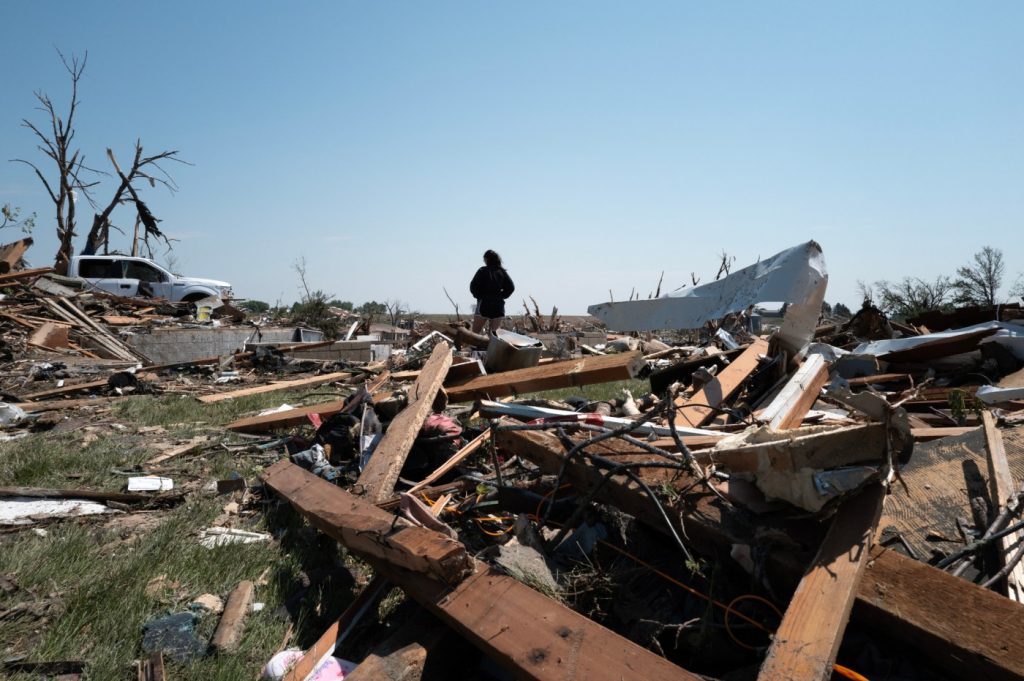By Hannah Fingerhut and Margery A. Beck | Associated Press
GREENFIELD, Iowa — Authorities in Iowa continued search and rescue efforts Wednesday while surviving residents picked through debris that had been their homes a day after a deadly tornado devastated the town of Greenfield and killed an undisclosed number of people there.
The tornado left a wide swath of obliterated homes, splintered trees and crumpled cars in Greenfield, a town of 2,000 about 55 miles (88.5 kilometers) southwest of Des Moines. The twister also ripped apart and crumpled massive power-producing wind turbines several miles outside the town.
Greenfield resident Kimberly Ergish and her husband dug through the debris field Wednesday that used to be their home, looking for family photos and other things that could be salvaged. There wasn’t much left, she acknowledged.
“Most of it’s gone,” she said. “Most of it we can’t save. But we’re going to get what we can.”
The reality of having her home destroyed in a matter of seconds hasn’t really set in, she said.
“If it weren’t for all the bumps and bruises and the achy bones, I would think that it didn’t happen,” she said.
About 25 miles (40 kilometers) southwest of Greenfield, a woman died Tuesday when the vehicle she was driving was blown off the road during the storms near Corning, Iowa, the Adams County Sheriff’s office said. The woman’s name and age were not immediately released.
Iowa Gov. Kim Reynolds and other officials held a news conference Wednesday morning but declined to give details of the number of dead and missing in Greenfield, noting that the amount of devastation and debris had made it difficult to be sure of those numbers.
Later Tuesday, the storms moved eastward to pummel parts of Illinois and Wisconsin, knocking out power to tens of thousands of customers in the two states.
The National Weather Service said Wednesday that initial surveys confirmed the damage in Greenfield indicated at least an EF-3 tornado, which would have wind speeds of 136 to 165 mph (219 to 265 kph). But those findings are preliminary and could change following additional damage assessment over the coming days, the weather service said.
The deadly twister that hit Iowa came amid a historically bad season for tornadoes in the U.S. at a time when climate change is heightening the severity of storms around the world. April had the second highest number of tornadoes on record in the U.S.
Through Tuesday, there have been 27% more tornadoes in the country than average. The preliminary count for this year of 859 is the highest since 2017 and is significantly more than the average of 676 through May 21, according to NOAA’s Storm Prediction Center in Norman, Oklahoma. Nearly 700 of the tornadoes have been in April and May.
Iowa has had the most tornadoes this year with 81, followed by Texas with 74 and Kansas and Ohio each with 66. The National Weather Service said it received 23 tornado reports Tuesday, with most in Iowa — including the one in Greenfield — and one each in Wisconsin and Minnesota.
The tornado that leveled Greenfield brought to life the worst case scenario in Iowa that weather forecasters had feared, AccuWeather Chief Meteorologist Jon Porter said.
“Debris was lifted thousands of feet in the air and ended up falling to the ground several counties away from Greenfield. That’s evidence of just how intense and deadly this tornado was,” Porter said.
The deadly tornado appeared to have been on the ground for more than 40 miles (64 kilometers), he said, and the damage wrought by it was the worst he had seen since an EF-4 tornado — with wind speeds between 166 and 200 mph (267 and 320 kph) — hit Mayfield, Kentucky in December 2021.
A mobile research radar in the area of the Greenfield tornado detected wind speeds higher than 200 mph (320 kph), which is the threshold for an EF-5 tornado, Porter said.
“But that measurement was taken roughly 600 to 1,000 feet above the ground. It’s the severity of damage on the ground documented during storm damage surveys that dictates the strength of a tornado,” he said.
Greenfield’s hospital was among the buildings that were damaged in the town, which meant that at least a dozen people who were hurt had to be taken to facilities elsewhere, Iowa State Patrol Sgt. Alex Dinkla said Tuesday night. A triage center was set up for the injured at the Greenfield high school. The Adair County Health Department reported that a Methodist Church also was being used to treat the injured.
White House Press Secretary Karine Jean-Pierre said FEMA’s administrator would head to to Iowa on Thursday and the White House was in touch with state and local officials.
“We are praying for those who tragically lost their lives as deadly tornados ripped through Iowa,” she said. “We are also wishing a speedy recovery to those who were injured.”
On Facebook, people as far as 100 miles (160 kilometers) away from Greenfield posted photos of ripped family photos, check stubs, damp yearbook pages and other items that were lifted into the sky by the Greenfield tornado.
The tornado tore through houses on the southwest corner of Greenfield and traveled toward the hospital on the east side. Residential streets that on Monday were lined with old-growth trees and neatly-appointed ranch-style homes were, by Wednesday, a chaotic jumble of splintered and smashed remnants. Many of the homes’ basements where residents sheltered lay exposed and front yards were littered with belongings from furniture to children’s toys and Christmas decorations.
Ergish, 33, said she gathered her four kids and went into the basement when the sirens sounded “and just kind of huddled in the corner.” Seconds later, they were covered in the debris from their destroyed home.
“It was like 10 seconds of pure terror,” she said. “It felt like it lasted a lifetime.”
The family, which has lived in Greenfield for eight years, escaped with minor injuries. Ergish said that as much as she loves the town, she’s not sure whether they’ll stay.
“It’s kind of traumatizing at the moment,” she said.
The tornado also apparently took down several 250-foot (76-meter) wind turbines just southwest of the town. Some of the turbines caught fire, sending plumes of smoke into the air. Wind farms are built to withstand tornadoes, hurricanes and other powerful winds.
Mary Long, the owner of Long’s Market in downtown Greenfield, said she rode out the storm at her business in the community’s historic town square, which largely escaped damage.
“I could hear this roaring, like the proverbial freight train, and then it was just done,” she said.
Iowa had braced for severe weather after the weather service’s Storm Prediction Center gave most of the state a high chance of seeing severe thunderstorms with the potential for strong tornadoes. Earlier in the day, residents to the west in Omaha, Nebraska, awoke to sirens blaring and widespread power outages as torrential rain, high winds and large hail pummeled the area. The deluge flooded basements and submerged cars. Television station KETV showed firefighters rescuing people from vehicles.
In Illinois, dust storms led authorities to shut down stretches of two interstates due to low visibility.
In Wisconsin, the weather service’s Green Bay office dispatched a staffer Wednesday morning to survey storm damage near the village of Unity in western Marathon County after law enforcement received a report from the public about a tornado on the ground about 7:45 p.m. Tuesday in that community about 55 miles (89 kilometers) east of Eau Claire, said meteorologist Roy Eckberg.
Weather service staff also planned to assess storm damage Wednesday in southeastern Minnesota after radar indicated a tornado touched down Tuesday night in Winona County, said Kate Abbott, a meteorologist with the agency’s La Crosse, Wisconsin, office.
Beck reported from Omaha, Nebraska. Associated Press writers Steve Karnowski in Minneapolis; Josh Funk in Omaha, Nebraska; Colleen Slevin in Denver and Juan Lozano in Houston contributed to this report.


